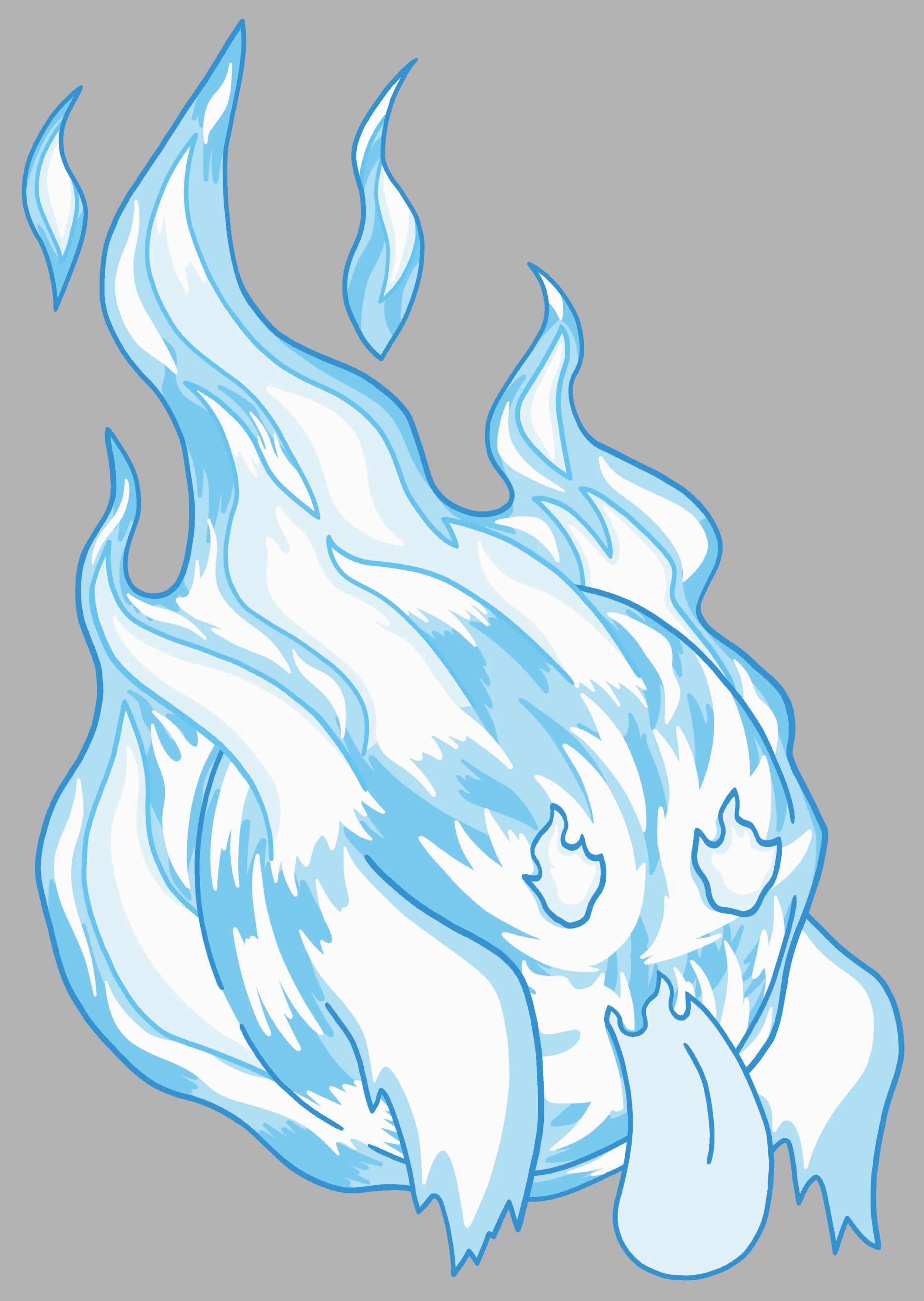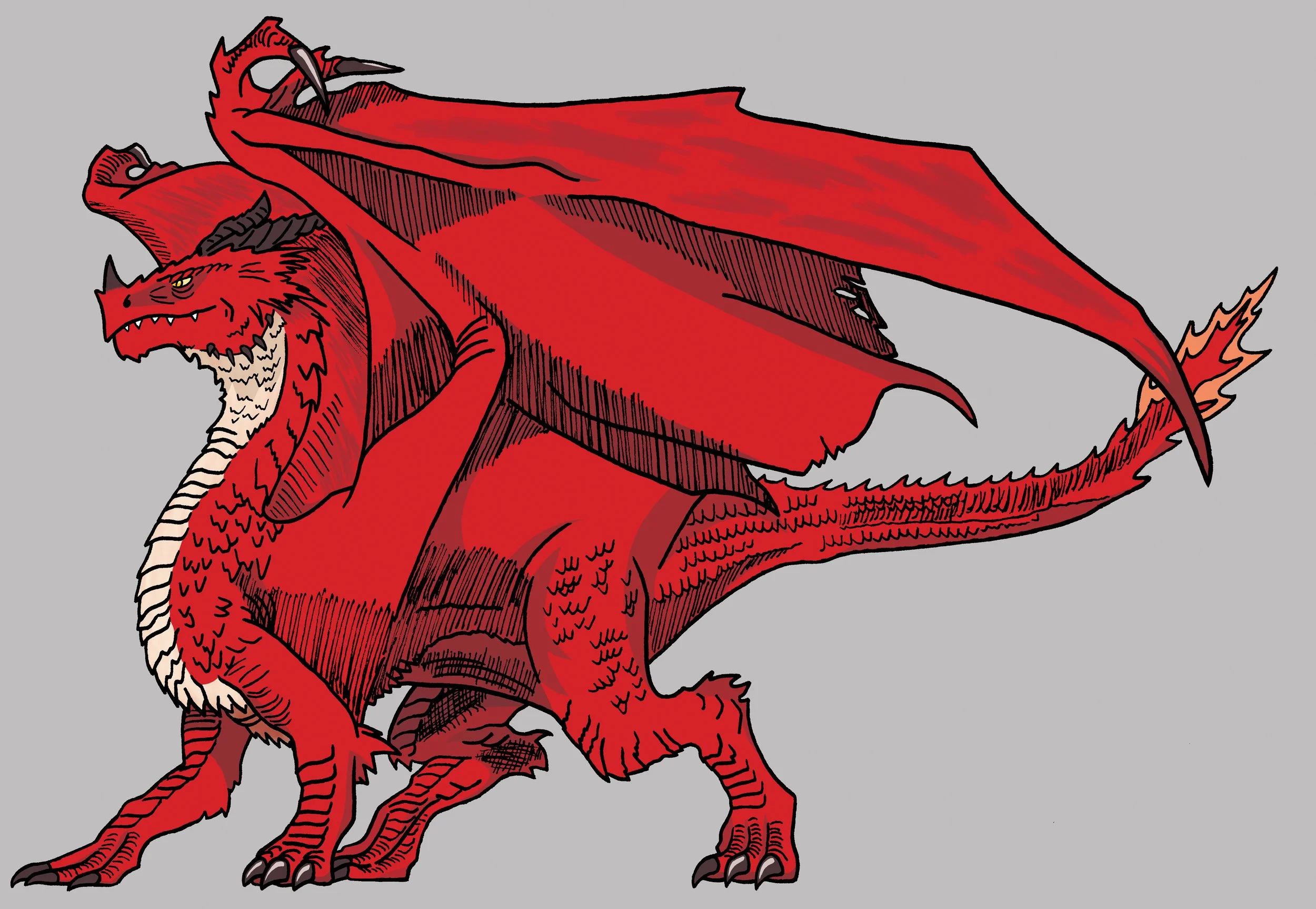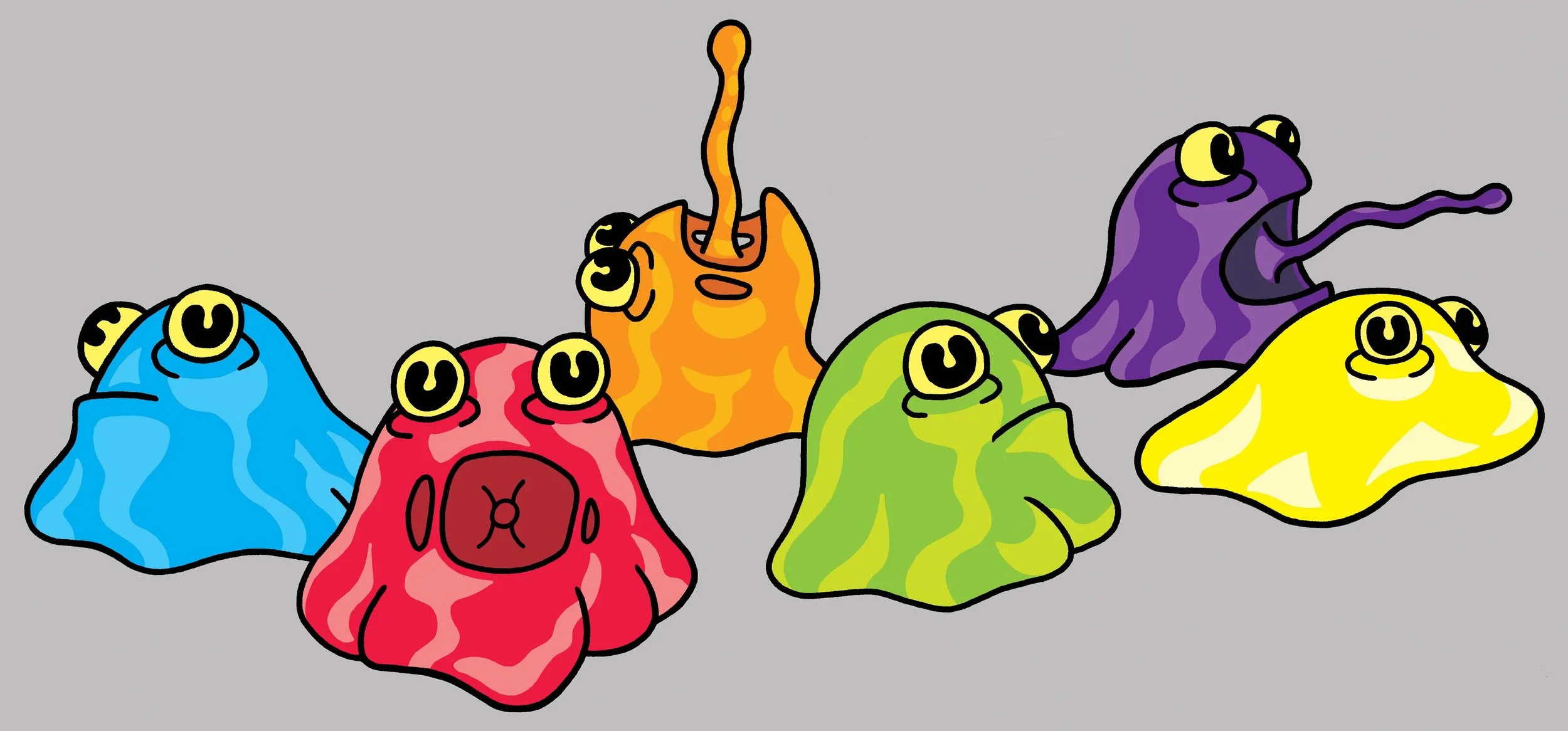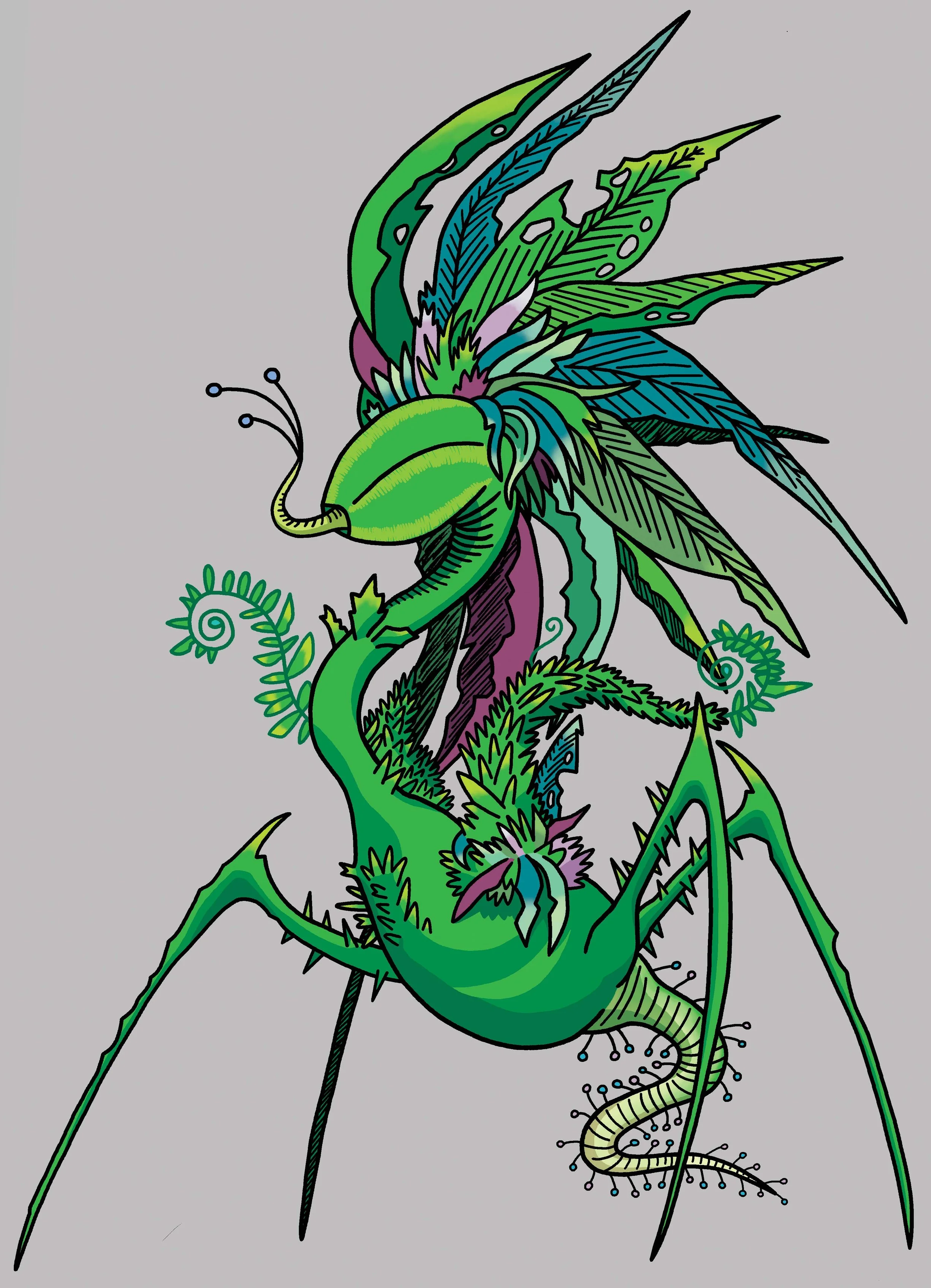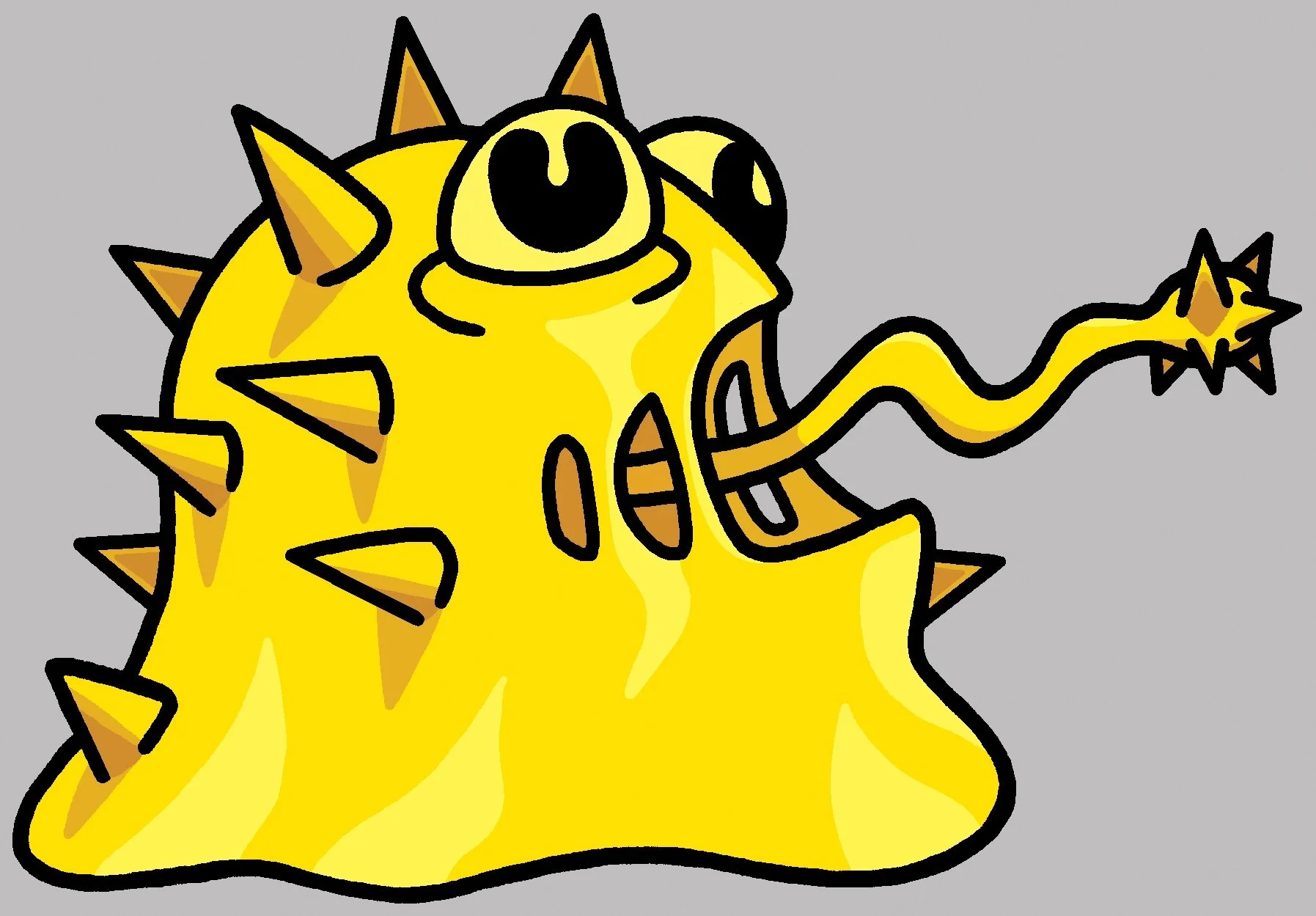HITODAMA
Identification: Fëa Lulikki. Element: Death. Dlvl: 4. Social Unit: Hauntings (3+). Diet: Unknown, possibly souls or negative emotions. Habitat: Residential areas, Abandoned structures, Gravesites, Forests, Grasslands, Mountains, Caves, Deserts, The Underneath. Status: Common.
Balls of ghostly fire that materialize around haunted locales. Once believed to be related to the souls of the departed, like the common ghost, their common familiarity in the wild has led to many scientists theorizing that Hitodamas may be the cursed souls of other wild animals. Another popular theory is that they are merely the appearance of a soul that has left the body, representations of a wandering spirit, not unlike an elemental or golem and their personification of the elements. Though like many undead fauna, theories about the Hitodama cannot be proven and Hitodamas’ existence remains a mystery.
What isn’t a mystery about Hitodamas is that they are undead animals that prefer the company of other undead beasts, referred to as hauntings, and can easily be found in many forests across Ra at night. Hitodamas are most commonly found in the company of ghosts and other ethereal creatures that personify the mortal soul. Hitodamas also seem to enjoy scaring people the most, rather than attacking and feeding on astral energy. Although more than capable of defending themselves with low-level death magic, Hitodamas often try to flee before engaging in a fight. This fright-and-flight tactic has led to many thinking that Hitodamas, and many other undead creatures, feed on fear by scaring people.
Though they offer no valuable loot upon defeat, Hitodamas are also reputable hoarders and natural thieves, and their hidden hoard can be found near by, often buried in an abandoned grave or hollow tree. Although it is possible to coexist and even keep a Hitodama as a familiar, their natural scaring abilities make them unpredictable in domestic homes. Scaring and startling their handlers is best treated as some sort of game for the Hitodama’s amusement, lest they become more violent and destructive. Since they don’t really need to eat and get plenty of sustenance from tricking and scaring people, they make very cheap and manageable familiars, however are very difficult to keep around other living creatures and families, especially those with kids.
LEAF SLIJ
Identification: Slij Léhfti. Element: Flora. Dlvl: 8. Social Unit: Globs (3–8). Diet: Omnivorous. Habitat: Grasslands, Forests, Urban areas. Status: Common.
The most common floral-elemental slij species. Leaf Slij are a deeper, more plant-based green than the common green slij, and have manipulated a part of their slimy body to form a leaf-shaped protrusion on their head. No matter the size of the slij, the leaf disguise rests atop their head, even when they flatten down to rest for the day. This gigantic leaf disguise acts as camouflage and helps the slij blend in to their surroundings. When Leaf Slij flattens to rest, they often group together to look more like a pile of gigantic leaves. Not the most subtle of disguises in the animal kingdom, but effective enough to fool unwary prey or the occasional hunter as they pass by.
Leaf Slij are omnivorous but show a preference for aerial prey like birds and large insects. When disguised, from above they most accurately resemble gigantic leaves no matter their form. An ideal opportunity for the Leaf Slij, who can strike flying prey from below with their prehensile tongue. To wound or stun more aggressive prey in battle, Leaf Himbas also use low-level flora magic and camouflage magic to escape if the fight is too much for them.
Nobros
Identification: Nobro. Element: Null. Dlvl: 11. Social Unit: Packs (5+). Diet: Omnivorous. Habitat: Residential Areas. Status: Common.
Troublesome creatures found in major urban areas. Regarded as somewhat of a pest in neighborhoods and cities — their species name roughly translating back to ancient ork for “unfriendly” — Nobros are a unique creature with the sole species making up the entirety of their class, order, family, and genus. Composed of a semi-transparent, gelatinous, bipedal form Nobros root around the back alleys of cities for gods-only-know-what as their dietary habits remain a mystery. So far, it has been shown that Nobros have no dietary limitations and are capable of digesting just about any matter. They are omnivorous and show no weakness to even the most acidic, rotten, or poisonous of substances. Nobros in larger cities are shown to even digest metal and plastics, matter seemingly dissolving inside their translucent forms. One would think this a godsend for environmental protection and recycling (and at one point in nature it probably was) were it not for their thieving nature.
Like the common dire rat or brownie, Nobros are primarily nocturnal creatures that spend most of their time rooting through garbage cans and filth. they don’t just feel comfortable stealing loot or loose shards from peoples’ pockets, but everything and anything they can get their grubby little stubs on. This includes not just stuff from peoples own backyards but stop signs, traffic signals, and anything and everything they can carry. To make matters worse, whatever a Nobro possesses that they cannot consume the Nobro uses as a weapon for self-defense, if they don’t decide to just lob it at random civilians for their own amusement first. Despite their rogue-like and troublesome nature, Nobros are fairly easy to dispose of for experienced warriors and plenty of stores sell products specifically designed to ward of Nobros.
Nuppeppo
Identification: Nuppeppō Nuppeppō. Element: Death. Dlvl: 7. Social Unit: Solitary. Diet: Chives and onions. Habitat: Graveyards, ruins, caves, residential areas, swamps, deciduous forests, and boreal forests. Status: Uncommon.
Featureless lumps of living meat, few have seen the mysterious ways of these shapeshifting blobs. Nuppeppō have neither eyes nor ears, yet show understanding and direction of movement when active. They will shape themselves, simulating the needed sensory organ when intense concentration is needed. The popular theory is that Nuppeppō are reanimated stomachs, a theory supported by their appearance and most common habitats. When idle or “walking,” Nuppeppō take on a lumpy form (pictured here) that looks like a removed, mammalian stomach flipped upside down. Nuppeppō are most commonly found in ruins, caves, and other areas where dead adventurers and skeletal remains are plentiful. However, unlike true undead creatures, Nuppeppō have a preferential diet and eat only vegetables of the allium genus: onions, leeks, scallions, et cetera, with chives being their favorite.
Nuppeppō are considered mostly harmless and curious creatures. Their never-ending quest for onions casues them to explore every nook and cranny in their environment for delicious onion bulbs. Most Nuppeppō will even keep a secret garden of onions — sometimes even a communal one — that they will tend to, ensuring a nearby stock of food is never out of reach. Nocturnal animals, Nuppeppō use their flappy, little appendages, or sometimes the shape of a hand or claw, to burrow underground during the day. Underground, the Nuppeppō are known to make small nests not much bigger than themselves. These Nuppeppō nests are always adorned with skeletal remains. In more adventurous areas like caves, ruins, and graves the nests may be built around more humanoid skeletons, and in the wild mammalian skeletons are common place around Nuppeppō nests. Another behavior that lends itself to the “reanimated stomach” theory.
Nuppeppō also pose no threat to travelers or other wildlife unless provoked. Strong death spellcasters, Nuppeppō have no external attacks except to shape shift into more offensive forms, but the law of conservation of mass means they can’t get much bigger than their idle, lumpy form. Nuppeppō can also be easily warded off with commonly sold sprays, oils, and other wildlife prevention methods, they are particularly annoyed by ward chimes and bells. Nuppeppō are also edible and have a sweet, meaty flavor, but aren’t commonly farmed or domesticated due to their powerful death magic capabilities.
POLINTUS
Identification: Isomáti Ochavwe. Element: Null. Dlvl: 5. Social Unit: Solitary/ Huddles (10+). Diet: Carnivorous. Habitat: Deciduous forests, Boreal forests, Residential areas. Status: Common.
One of the world’s most widespread feral creatures, the Polintu species is an oddity that has fascinated scientific communities for generations. A plump, awkward, flightless bird, the Polintu is commonly found in many of the world’s cities, towns, villages, forests, woodlands, and parks. Naturally, the most distinguishing feature of the Polintu is the large, singular, eye that dominates most of its body.
The eye and all its functions take up about 70% of the Polintus’ entire biological capabilities. Even the Polintu’s brain has reduced in size over the evolutionary years and been pushed back, nestled behind the large, monocle eye. Polintus see in multiple spectrums at all times including: the visible spectrum, infrared, night vision, ultraviolet, and even radio waves. It is even believed they can see multiple spectrums unrecognizable to our eyes. Polintus' other sensory traits are extremely limited to make room for their sight abilities. For example, they are barely capable of hearing and have very limited taste receptors. The Polintu eye is also capable of firing a type of stunning laser unique to the Polintu, they use this to wound and knockout prey they can then snare with their sharp, little beaks. Not just limited to their unique Polintu laser, most Polintus share a keen aptitude to learn multiple types of non-elemental spells they cast from their eye; most spells being in the form of laser attacks.
Due to their aggressive nature and large appetite, Polintu populations are often studied and maintained to ensure they don’t wipe out local rodent or bird populations beneficial to the ecosystems. Able to extend their jaw to half the size of their eye, Polintus have a small, hooked beak with small serrrated teeth lining the inside of their beak. They are one of a few rare bird species to actually have teethPolintu are also considered “quarry” species and open seasons on Polintus are often called 2—5 times a year. Hunted Polintu eyes are common loot that fetch a fair and moderate price in most bazaar trades, the eye being a common ingredient in many potions, crafts, charms, and traps. When mixed into a potion or charm, the eye offers protection and/or strength buffs for projectiles.
RAZORED KOPPADAS
Identification: Koppada Koppada. Element: Water/Tropical. Dlvl: 37. Social Unit: Solitary. Diet: Fish, insects, amphibians, crustacea, and small mammals. Habitat: Wetlands, tropical rivers. Status: Rare, conservative.
A rare and unique amphibious species, the Razored Koppada closest resembles that of a salamander or newt, yet exhibits traits similar to that of chameleons and alligators. Razored Koppadas average about 3 meters in height and get their most unique trait from the blade-like, exoskeletal, protrusions lining their back with a single dominant “horn” at the snout. These protrusions are similar to a bladed weapon and though they are not actually made of steel, their composition is just as durable and sharp as a sword. Spending most of their time submerged in freshwater, Koppadas have developed large legs built for swimming despite their clawed appendages over webbed ones, which are ideal for swimming. This makes their posture on land cumbersome and slower compared to their swim speed.
RED DRAGONS
Identification: Draco Carnë. Element: Fire. Dlvl: 56. Social Unit: Antisocial. Diet: Carnivorous, particularly red meats. Habitat: Mountains, caves, grasslands, boreal forests. Status: Rare, endangered.
The Red Dragon is by far one of the most feared and famous creature in the history of this world. With a 31m wingspan and the ability to breathe fire it is the largest and most territorial of the true draconic species. A quadruped with a massive body, a long tail, serpentine neck, and scaly armor surmounted by bat-like leathery wings, Red Dragons are highly intelligent, enigmatic creatures that have a long and revered relationship with the people inhabiting their territories. While it is true that the Red Dragon is one of the rarest of dragon species, its protected status for hundreds of years under the Dragon Rescue And Conservation Organization has allowed the animal to survive to this day. Like other True Dragons, the female Red mates only once every few years and her gestation period is extensive, lasting up to 14 months. A clutch usually consist of three eggs which are fiercely guarded by both mother and father. When the hatchlings are born they are no more than the size of a puppy and require great care and attention for several years. Once the hatchlings have learned to fly, they leave the lair to begin looking for new territory
Adult Red Dragons are extremely solitary animals and become very antisocial by nature on their own. Once hatchlings have matured and left the nest, the parents’ destroy their nest and part ways to their own hoards in solitude, though parents’ often reunite to raise another clutch of hatchlings once mating season returns, for once Red Dragons have chosen a mate they will choose no other. When living alone, Red Dragons build impressive nests called hoards, and have a fascination with shiny and glinted objects that they collect and treasure as keepsakes. Red Dragons can live for hundreds of years, with their hoards becoming impressive monuments to their age.
SERBALIAS
Identification: Sarbaalis Sarbaalis. Element: Flora. Dlvl: 35. Social Unit: Herd (5-15). Diet: Cacti, brittlebrush. Habitat: Deserts. Status: Rare, conservative.
Gentle, reptilian, giants of the desert, Serbalias spend much of their lives wandering the deserts of Ra in search of food. Herbivorous creatures, Serbalias consume mostly cacti, for which they get most of their nourishment and water intake. In fact, Serbalias are so naturally equipped to consume cacti to the root, that scientists theorize they must have evolved alongside cacti, developing traits that mimic cacti down to its defense mechanisms. Serbalias grow cacti-like humps that serve a dual purpose to the Serbalia. The first is obviously defensive, these cacti-humps grow on the outside like an organic, exoskeletal-like plate. The second purpose of this cactus-hump is for food storage. Life in the desert is rough and food is often scarce, the Serbalia has adapted to this lifestyle by storing fat and water in the humps on its back. Each one of these cactus-humps is a pocket for storage, so the Serbalia can have as many as 3 to 20 pockets on average. Obviously the more pockets, the better the Serbalia’s chance for survival when food is scarce, but that is up to the luck of genetics to decide. The Serbalia is a very docile giant but can easily defend itself with its size, tail, and spiny cactus-hump, crushing all who threaten its herd.
As mentioned earlier, the Serbalias’ cactus-humps store a mixture of fat and water known in qazalan culture as “Serbalia Nectar.” In ancient times, Serbalias were hunted like other animals as a food source and greatly impacted some qazal cultures up until the earlier centuries of the second age. When Serbalia populations began to dwindle, it became obvious how much their presence impacted the ecosystems of their deserts, and hunting Serbalias was quickly outlawed. Today, in order to extract Serbalia nectar, the beast is hunted and sedated by specially licensed hunters through a lengthy and arduous milking process.
HIMBAS
Identification: Slij láspi. Element: Null. Dlvl: 5. Social Unit: Globs (5—50). Diet: Omnivorous. Habitat: Deciduous forests, Boreal forests, Grasslands, Caves, Mountains, Fresh Waters, Shallow Seas, Rain forests, Urban areas. Status: Common.
Slij Iáspi, or the Common Slij, is the most identifiable and widely dispersed species of the slij slime creature family. Simply referred to as Slij by the average person, the Common Slij is identified by its simple form and wide arrange of colorful variations, to which they are also referred. Pictured here is an example of the full spectrum of Common Slij subspecies: Green, Blue, Red, Yellow, Orange, and Purple.
Individually, the Common Slij poses little threat to anybody bigger than a small child, but don't be fooled a wild Slij never travels alone. Found in globs ranging from 5-50 Slij, their highly aggressive nature often finds the pack facing much larger predators the Slij commonly mistake as prey. With a reach of up to 7 meters, Common Slij use their tongue, covered in a numbing, adhesive-like coating, to attack unwary prey and predators quickly and quietly. Stealth and sneak attacks are the strengths of these slow-moving slime monsters, and to the unwary adventurer the Slij will quickly absorb and consume them.
Despite their aggressive nature, Slij have become popular creatures of culture, probably due to their adaptability to almost any environment and appearance. In a docile state, Slij look rather clueless and unintelligent and will try to consume almost anything. This has made Slij popular house pets, especially amongst orks who produce a large quantity of waste in their day-to-day lives. Slij jellies are also a common loot item used in the crafting of many basic potions and elixirs.
SPECTER
Identification: Fëa Latvä.. Element: Death. Dlvl: 23. Social Unit: Undefined. Diet: Fear. Habitat: Wherever deadly energy is present and death has occurred. Status: Rare.
Shapeless negative emotion, coalesced and made manifest through magical rites. Fear, anger, sadness, aggression, all these negative emotions remain in traces for time where men have slaughtered and blood has been spilt. It is there where Specters are known to arise and take ethereal form. Specters are composed of little more than fear itself, and are drawn to the remnants of other negative emotions. Though rarely seen by mortal eyes, when they do reveal themselves, whether willingly or by force, Specters often appear like astral sheets of living energy, a single, ghostly flame hovering above a hollow hole is the only feature that seems to represent some sort of eye, or any facial feature really. Unlike the common ghost, Specters are not bound by curses or enchanted relics and typically arise wild and free. However, Specters are still undead souls, and adhere to the same natural laws of nature as other undead creatures, some scholars theorize they may even be the undead soul of a certain type of animal species, though these are unsubstantiated rumors at best.
Drawn to negative emotion, but feasting solely on fear, Specters are liable to attack when fear is heavy within the traveling party. Specters are one of the undead creatures best at becoming incorporeal and can often remain invisible even when attacking. Unless forced out by light magic or other holy means, Specters may never reveal their true form to the material world unless they choose. Specters are far more aggressive than ghosts and will attack prey as soon as they sense fear is nearby. Relentless in their pursuit and tactile in stoking the essence of fear, Specters will attempt to rend their victim’s soul from its mortal shell, until only fear remains.
SWIFTLEAF TARAKONAS
Identification: Tarakona Whapodylus. Element: Flora. Dlvl: 33. Social Unit: Reclusive. Diet: Water, sunlight, meat. Habitat: Rainforests, wetlands. Status: Rare.
A species of predatory plants belonging to the most deadly and aggressive families of carnivorous flora-fauna. The “swiftleaf” are one of the most ambulatory of tarakona species, having evolved an odd serpentine neck, out of which a mane of massive leaves grow to hide its shape amongst the jungle. Four-legged plants with thin, needle-like appendages to walk around on, Swiftleaf Tarakonas are one of the most unpredictable creatures that stalk the shadows of the rainforest jungles. Swiftleaf Tarakonas move their bodies in quick, swaying, skittering bursts of energy to confuse wary prey and the would-be predator as well. Though the Swiftleaf is usually the apex predator of its environment, they do still need to occasionally compete with other hunters for prey.
Swiftleaf Tarakonas also have a large, stomach-like body that carries a pool of highly acidic, burning, digestive juices that quickly break apart small prey, like rodents and insects. But larger prey usually needs to get broken down limb by limb to be digested, and that is why the “mouth” of the Swiftleaf is lined with little, razor-sharp, serrated fangs on the inside of each mouth-leaf. Clamping down on limbs of its prey, the Swiftleaf rips and tears apart the meat, while its digestive juices leak out and quickly burn the flesh to be digested. Their mouth also hides a prehensile, proboscis-like, appendage that many scientists believe serves multiple functions. A whip-like, defensive mechanism, the proboscis can be used to attack prey and predators by flinging the digestive juices around to button and boil away the skin of anything it touches. It is also widely believed the proboscis also helps the Swiftleaf “see.” Like a snake using its tongue to sense the world around it, Swiftleaves constantly flick their tongues in and out to sense movement and the air around them, identifying their environment and prey. Normally, these are rare and powerful predators to face, sticking to the shadows of the jungle. It is more likely a Swiftleaf Tarakona will see you before you see them, but it may be too late before you feel the boiling sting of its acidic juices.
SPIKY SLIJ
Identification: Slij Tilde. Element: Null. Dlvl: 11. Social Unit: Globs (5—10). Diet: Omnivorous. Habitat: Deciduous forests, Boreal forests, Rainforests, Residential areas. Status: Common.
A species of slij that has developed a series of protruding spikes similar to spikes found on some shelled animals. Other than that, this species of slij behaves similarly to other slij. Spiky Slij are able to control the hardness and sharpness of their spikes, but not where they grow on their body. It seems since birth, the cells of the slijs’ spikes grow and harden randomly around the upper part of the slij’s body. Even separated as jelly, the cells react instinctively and form new spikes along the jelly. When a Spiky Slij flattens its body to move faster, the spikes soften and become more squishy until the slij expands its body again.
Spiky Slij use their spikes entirely for defense. They shield themselves from predators with their spikes and thrust their bodies into sturdy prey to wound them. They can even concentrate real hard and make their spikes extend a few extra centimeters outward, making the spikes even sharper. Spiky Slij tongues are also armed at the tip with a set of spikes that skewer and hold on to smaller prey with a tighter grip than the average prehensile tongue.
TWO-TOED FERRETS
Identification: Mustela tweeteen. Element: Ice. Dlvl: 3. Social Unit: Asocial (4-6). Diet: Birds, eggs, frogs, and small mammals, . Habitat: Tundras, mountains, deciduous forests, boreal forests. Status: Common.
A common species of mustelid native across the northern tundras of Ra. The Two-toed Ferret is similar in appearance to most other weasel species, its build, size, features, and length of its body similar in appearance. The larger, elongated, two-toed paws for which it gets its name is one of the species’ few distinguishing features and allows them to either walk across the surface of snow or stalk prey along the ground covered by the snow. Like most other weasels and ferrets, the Two-toed Ferret has evolved an exposed membrane along the spine; when upright, the fin-like membrane can act as a “sail” that helps the ferret leap almost twice the distance it could without the “sailfin” membrane. This species also uses its sailfin to cut trails in thicker snowfields, the fin, similar to a surk fin as it pokes above the snowy surface, cuts a thin trail while their white fur disguises them in the snow.
Despite their diminutive size, Two-toed ferrets are ferocious carnivores whose diet includes birds, reptiles, insects, and other rodents. They are even known for taking down prey twice their size either alone or aided by other ferrets. In addition to an impressive leaping ability and oversized, sharp claws on their feet, Two-toed ferrets also possess low-level ice magic abilities which they frequently use for distance attacks and to freeze larger prey or predators.
Also known as the western snow ferret, the Two-toed Ferret was introduced to the northern regions of Pan in the late 3rd age to help control the rabbit population outside Baior, today the Two-toed Ferret is a dangerous and invasive pest that threatens the population of the regional bird and rodent populations.
WATER ELEMENTALS
Identification: Elemódis Nér. Element: Water. Dlvl: 40. Social Unit: Summons (3–5). Diet: Residual magical energy. Habitat: Any body of water. Status: Rare.
Like all other elemental species, Water Elementals embody and control the energy of the water element. Inhabiting any body of water they choose, from the smallest ponds to the largest oceans, Water Elementals are one of the few elemental species to have subspecies. In this case, Water Elemental species are identified by the body of water they reside in, categorizing them in two different genus: Freshwater and Saltwater Elementals. Saltwater Elementals are naturally the most common species and have a slightly greener tint than the natural blue of the Freshwater Elementals. Water Elementals are especially difficult to spot in the wild as they spend most of their time submerged in the body of water they inhabit, nearly impossible to see except for small circular ripples and shimmers that occurs unnaturally and move about freely like small, dancing shadows on the surface. However, they are more docile elementals than most other species, and in some rare occasions are even friendly to sentient visitors. Behavioral studies with Water Elementals have yet to identify why these creatures leave the water at all, perhaps it is for social reasons, even though the elementals create no noise to communicate.
Water Elementals are especially weak to electrical-based damage and loose hold on their composition when weakened. Containing bits of their weakened form in bottles rewards Water Essence, a necessary component in water tonics and merfolk craftsmanship. Though they are not known for starting battles, Water Elementals are difficult opponents, using multiple water spells in unison to dispatch foes. Water Elementals are actually one of the few elemental species to prefer fight over flight.
Wyverns
Identification: Draco Vipera. Element: Null. Dlvl: 52. Social Unit: Antisocial. Diet: Carnivorous. Habitat: Caves, tropical forests, and boreal forests. Status: Rare, endangered.
Unlike most dragon species, the Wyvern is a prehistoric beast, an apex predator, a perfect killing machine surviving since the ancient days of Ra. The Wyvern is a species of dragon with a limited range in territory, only found in one of the six dragon’s nests of the world, and with no threat in predators or competition for prey, the Wyvern has remained evolutionarily unchanged for millennia. Unlike most modern dragons, the Wyvern has retained its ancient, feathery appearance, which conceals patches of weaker dragonscale armor that protect vital areas of the Wyvern body. The Wyvern’s tail is also a uniquely barbed tail similar to a scorpion with a venomous tip; it too is concealed by a large feathers at the end of the tail. Other than its feathers and tail, Wyverns are most identifiable by being the only true dragon species with two legs, their wings starting at the wrist of their claws in a chiroptera-like fashion, this appearance leaves scientists to believe that other ancient dragon species walked on two hind legs like the Wyvern.
Wyverns are also the species of true dragon with the weakest dragon breath, although it is still a great deal dangerous to people. Wyverns mostly rely on quick, brutal, physical attacks to weaken prey before delivering the killing blow with their jagged rows of teeth. In order to ensure wounded prey doesn’t escape too far, Wyverns usually try to get the first strike against prey with their venomous tail. Uncontested killers, Wyverns are a representation of pure rage in the dragon kingdom, feared by other dragons it is hotly contested if Wyverns are even more dangerous than red dragons.
Yarrhwols
Identification: Yarrh’a Wolo’Nahesa. Element: Flora. Dlvl: 17. Social Unit: Solitary. Diet: Sunlight, water. Habitat: Tropical forests, Grasslands. Status: Regional Common.
Yarrhwols are large patches of living grass that resemble a snake or serpentine body. A species of flora-fauna found mostly in areas with heavy vegetation, like rainforests, or in large, open areas with tall growing grass. Yarrhwols get their common name from a translation of wauan words that roughly mean “slithering grass.” Yarrhwols simulate no facial features and rely on their “crown of tall grass” that grows from the brain-seed to sense the world around them. As the Yarrhwol slithers along the ground, wind blows through these tall grass blades, giving a sort of “sensory” update to the Yarrhwol in which direction it is moving, and the world around it. The Yarrhwols even use their grass to sense things like other plants around them, water sources, and — should they need it — when prey is nearby.
Yarrhwols are flora-fauna and, like most mobile plant creatures, live on a diet of mostly sunlight and water, but sunlight can be scarce in some forests. It could be days before a Yarrhwol get their fill of necessary sunlight. So, extra water becomes their next best source of nourishment. A Yarrhwol can go days without moving in order to conserve energy, but this isn’t always the case. The coloration of a Yarrhwol, much like regular grass, denotes when they are dehydrated, and a dehydrated Yarrhwol becomes a very aggressive and dangerous problem for any living creature. In times of desperation, a Yarrhwol’s roots can be used to root and drain the water from any other vegetation, similar to the proboscis-like roots of a barometz. Yarrhwols simply need to flatten out their body around the base of a tree or flatten any bush or fern and let their roots burrow into the plant like a million little hairs.
